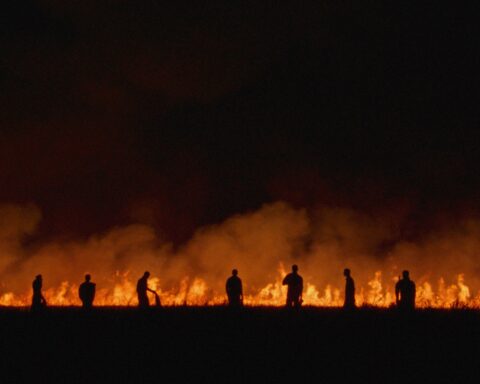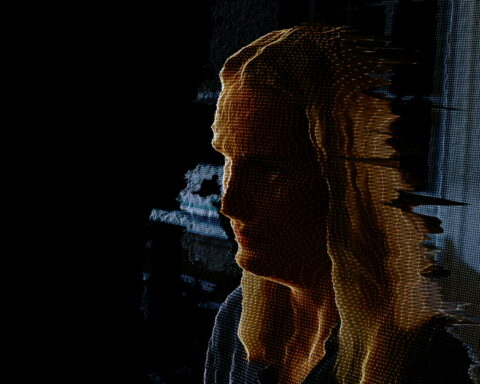The Scotiabank CONTACT Photography Festival has become one of Toronto’s cardinal points on the world art scene. Starting in 1997, it quickly grew to become one of the largest photography festivals in the world. Such festivals have become a mainstay of art capitals from Paris to Mexico City and usually for a month become international meeting places for artists, curators, collectors and all who love photography. And who doesn’t? We are saturated with images more than ever, but we still can’t get enough. In the past few years Toronto’s festival has been attracting annually approximately 1,500 photo artists exhibiting in some 200 venues spread out across the city, from the most venerable public museums and private galleries to humble tucked-in-the-corner galleries.
This year’s festival is no exception, with three international bodies of work being presented for the first time in Toronto and Canada. History, memory and archives are big subjects in photography, and the camera’s role as witness to history not only affects our memory of the past but also how we perceive the present. Archives are where we safe-keep our memories.
Memory Unearthed: the Lodz Ghetto photographs of Henryk Ross
at the Art Gallery of Ontario (AGO)
This brilliantly curated show takes us back to a dark time in history through prima facie documents: almost 200 original photographs of the harrowing existence of the Jews in the Lodz ghetto in Poland, as they awaited a fate of extermination at the hands of the Nazi regime between 1940 and 1944. The ghetto had a population of 164,000 Jews in an area of 2.4 square km that had been fenced off and sealed by barbed wire. It was a “way station of death”: the residents toiled in factories and provided cheap labour for the Third Reich, while they waited for transport to be organised to the annihilation camps at Chelmno and Auschwitz. The ghetto was liberated by the Red Army in January 1945, but by that time fewer than 7,000 Jews had survived either the squalid living conditions or the gas chambers.
One of the survivors was Henryk Ross (1910-1991), one of two official photographers at Lodz Ghetto. Invading armies always seem to like to record their human trophies, and Ross’s job was to take thousands of identification photographs of ghetto residents and propaganda pictures for the Nazis. He did that, but he also did much more.
He understood the witnessing power of photography, and he decided to surreptitiously document daily life in the ghetto whenever he could, at great risk. He photographed from concealed spaces, through cracks in doorways or holes in walls. On one occasion he photographed Jews at the railway station as they were being deported. No one was allowed near the station, but he was able to hide inside a freight rail car with his camera, but then had had to wait 14 hours before it was safe to leave.
As the Nazis began to liquidate the camp, Ross buried over 6,000 negatives and other documents in the fall of 1944. He retrieved them in the spring of 1945, by which time many had disintegrated. Many years later Henryk said, “I buried my negatives in the ground in order that there should be some record of our tragedy…. I was anticipating the total destruction of Polish Jewry. I wanted to leave a historical record of our martyrdom…. I did it knowing that if I were caught my family and I would be tortured and killed.” Instead, his photographs were later used as evidence in the trial of the Nazi administrator of the ghetto, who was executed.
Some 3,000 negatives survived water damage and eventually they were given as a gift to the Art Gallery of Ontario by the Archive of Human Conflict.
The people at Lodz suffered unspeakable injustices. Some of these photographs are not easy to look at. But look at them we must. For Henryk Ross reveals the humanity that surfaces in the face of lingering, slow death sentences. What else can emerge but your humanity when you have been assigned to remove fecal matter and are ordered to pull and push a wagon loaded with a tank of feces, struggling like a beast of burden till your final days. This was a quicker death sentence, for fecal workers inevitably contracted typhus.
Ross was able to use whatever access he had for double duty, taking time to make careful compositions with artistry and sensitivity. He turned the camera on the vertical for a close-range profile of a barefoot woman and two men beside her, as they heave against the fecal wagon with all their might, her teeth clenched, her soiled feet pushing off the ground as if in a slow sprint. It is a consciously created photograph that easily transcends the moment of that woman’s tragedy. Having seen that woman, we will not forget her; she is etched into our memories. It was how Henryk wanted us to feel, for a photograph is “a point of view,” as Maia-Mari Sutnik so aptly put it in an insightful and poetic essay titled “Cruel Tragedies, Consoling Pleasures,” in the accompanying 244-page catalogue of the exhibition. Her essay should be singled out as a worthy tribute to the need for human beings to remember, and also to be remembered, and the role that photography plays.
As keeper of the Lodz archives, as “gardien,” an institution like the AGO takes on a hallowed responsibility, for the artifacts that make up the archive have now the status of sacredness, commemorating those who did not survive the gas chambers. We keep an archive as a dormant depository, and whenever we need to, it is there for us and our children’s children to use to replenish the soul.
Vanley Burke
at the Black Artists’ Network in Dialogue (BAND) gallery
The celebrated Jamaican-born British photographer Vanley Burke said, “A work never stops. It is important to breathe new life into the archive.” Burke grew up in rural Jamaica, and when he was 10 years old, his mother sent him a camera from Britain as a birthday gift. It was a Kodak Box Brownie, not a sophisticated camera, but it would change his life.
Soon after, he joined his family in Handsworth, a working-class district of Birmingham, England, home to a large Jamaican immigrant population. He began documenting life in his community and, as a young immigrant, was sensitive to issues of identity and belonging. It was the early 1970s, and “I was quite conscious of the negative aspects of the representation of black people in the mainstream press, and in general. It was always quite negative…and television programmes were invariably about war. The Biafran War was taking place at the time, and there’s the Congo…there’s the Kashmir War in Pakistan, there’s a whole guerilla warfare, a liberation struggle that was taking place in southern Africa, in west Africa and so on, against the old empires,” says Burke. “That all fit into and influenced how I went about in taking photographs.”
Burke continues: “History is normally written by the victor, and we were complaining as a group of people…[about] the way that the way our history was written and I think it was important, that having the opportunity to do something, I should document our own history. So that has been my passion ever since: to document the history of the black community in Handsworth, Birmingham.”
In a career that spans 50 years, he has become the foremost British photographer of the Black diaspora in the United Kingdom, documenting every aspect of the community from street life to shopkeepers to schools to funerals. His lifetime of work has become one of the most important photographic collections in the United Kingdom, and his archives include cultural artifacts (like funeral cards) that tell the story of the Black diaspora.
As a Black photographer he was able to photograph from within, having earned the complete trust of his community. He recalls his gentle encounter with a young boy with a bike flying a Union Jack, which resulted in “Boy with Flag,” 1970, one of his most famous photographs. He says, “For me it was just this young black kid with a flag on his bike—a Union Jack. It evoked a strange feeling in me. I mean, this whole thing about ‘belonging and identity’ was very strong at the time, and here’s this young kid, you know, just cutting across all these arguments with his bicycle and his flag, and I thought it was so brave and so wonderful of him, and I just took the photograph.” Children are challenging subjects because it is easy to romanticise their innocence. Burke’s photograph—a straight-on, eye-to-eye moment of true connection between two human beings who are somehow in solidarity with something higher than each of them—is resonant as a political statement. Totally devoid of artifice, it is reminiscent of the tenderness of the iconic photographer André Kertész.
If around his neck Burke carries a camera, on his shoulders he carries the burden of solidarity and responsibility toward his community. While in demand by museums and established art galleries, he has opted to show his work in many non-traditional venues such as community centres, schools, pubs and pool halls—wherever it is that people gather. His debut show in Canada is at BAND gallery, the Black Artists’ Network Dialogue, and is a selection from his early Handsworth pictures, as well as his more recent work from South Africa, Gambia and Jamaica.
The Gaze in the Other: Connections and Confrontations
at the Edward Day Gallery
Until very recently, the international image of Spain in photography was through outsider eyes. Ironically, some of the most iconic images in the history of photography are of Spain—but by foreign photographers. Consider the views that we have absorbed as cultural references for Spain: Robert Capa (Hungarian, later naturalized American) made the famous “Death of a Loyalist Soldier,” 1936; Henri Cartier-Bresson, the French father figure of photography, made “Children Playing in the Ruins in Seville,” in 1933, which became an iconic when it was published in his seminal book The Decisive Moment; and the legendary Eugene Smith (American) made the classic photo essay A Spanish Village, published in Life Magazine in 1955, which made Spain famous for the oppressive Civil Guards and the wake for a dead man. Later, Swiss photographer Jean Mohr’s picture of Spanish immigrants was published on the cover of his and John Berger’s book A Seventh Man. There were others, of course, but the prevalent view of Spain that we had for a long time was one of war, ruins, oppression, death and departing immigrants.
This has now changed, and those names and iconic images are being replaced by a host of Spanish names, as we can see in the first major exhibition of photography from that country to come to Canada, The Gaze in the Other: Connections and Confrontations, at the Edward Day Gallery. Photography in Spain went through a tremendous renaissance that began in the dying days of the Franco regime and evolved rapidly. In parallel with the transformation of Spanish society, a critical mass emerged in the field of photography. Magazines began to appear and featured the work of Spanish photographers (Afal, Imagen y Sonido, Nueva Lente), then galleries were established, publishing houses began to issue books on photography, festivals and conferences were organized in the major cities, and photographers were celebrated. The government established the prestigious Spanish National Photography Prize, in 1996, which so far has been awarded to 14 photographers.
The exhibition is a survey of the winners between 1996 and 2008. Of the photographers included, Cristina García Rodero is the best known in North America, being a member of the Magnum Photo Agency and having exhibited in the United States and Mexico. (Joan Fontcuberta, who is not in the show but is in the book, is also a recognised talent.) The others are becoming increasingly well known through a 324-page book that accompanies the exhibition. La Mirada (The Gaze) is magnificently printed and published in Spain by the venerable Lunwerg Editions. The show has already travelled to 10 cities: Lisbon, Ljubljana, Tokyo, New York, Washington, Miami, Mexico City, Buenos Aires, Santiago de Chile and La Paz. After Toronto, it will move to Brasilia.
The curators sought to trace the development of photographic aesthetics and styles over six decades in Spain, and include social documentary, photojournalism, conceptual work, eroticism, digital manipulation. It is a compendium of photographs that convey a cross-section of Spanish society according to the artistic tendencies of the photographers. The curatorial stance was to look for similarities and contrasts, and they achieved this by pairing photographs of similar but different photographers, or that reflect a complementary or contradictory style and approach. The themes featured include absences, infancy, religion, portraits, landscapes, couples, hands, feet, stones and more.
One of my favourite examples is “Bullfighter Lamb, 1973,” by Pablo Pérez-Minguez, paired with “Towards sacrifice” (2000), by Cristina García Rodero. The former, in colour, is a portrait of a man dressed in his unblemished bullfighter suit wearing a mask and holding a tiny lamb over his arm; the latter, in black and white, is of a young man carrying a goat on his back in a muddy river, on his way to a sacrifice. The contrast in style could not be greater, yet the similarity in content and in composition is eerily similar. The exhibition continues in this vein, and the viewer begins to look at the photographs in a completely new way, opening the door to new interpretations.
The festival also includes an eclectic and wide-ranging collection of exhibitions that highlight the important role of documentary photography both in art and in our everyday lives. Not only are we being treated to new interpretations of historical art photographs, but in an interesting twist, one exhibition shows us how the painter’s brush was influenced by the camera as a result of the artist’s own amateur photographs. The festival reaffirms our mythical love of the land with varied landscape photography, while provoking us to reflect on our urban world in terms of physical transformation of the cityscape and social contradictions. The Scotiabank CONTACT Festival has not only repositioned documentary photography on the high altar of Art with a capital A, but it also shows us how indispensible it is to understanding our past and our present.











